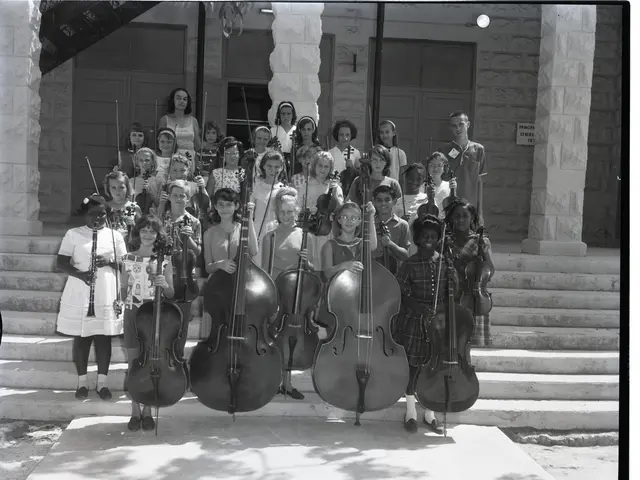U.S. Skies Could Be Re-Graced by Supersonic Air Travel
In a significant shift, the United States is gearing up for the potential return of supersonic flight over its mainland, marking a departure from a decades-long ban. This transition is driven by a combination of governmental and private sector momentum, with NASA and companies like Boom Supersonic and Spike Aerospace at the forefront.
The journey to this point began in June of 1963, when President Kennedy announced the creation of the National Supersonic Transport program. However, it wasn't until the 21st century that the landscape started to change. President Nixon supported the SST program, but the Senate rejected any further government funding for an American SST in March of 1971. In 1973, the Federal Aviation Administration (FAA) enacted 14 CFR 91.817, prohibiting civilian flight beyond Mach 1 over the United States without prior authorization.
Fast forward to mid-2025, and the development of civilian supersonic aircraft in the United States is advancing rapidly. This progress is underpinned by significant regulatory changes, with President Trump signing an Executive Order titled "Leading the World in Supersonic Flight" on June 6th. This order directs the FAA to repeal 14 CFR 91.817 within 180 days and develop a noise-based certification standard for supersonic aircraft.
The NASA and Lockheed Martin’s X-59 experimental low-boom supersonic demonstrator completed its first taxi tests in July 2025. Its goal is to gather data on sonic boom reduction to help set acceptable noise thresholds for civilian supersonic flight. Private companies such as Boom Supersonic and Spike Aerospace are also actively developing supersonic airliners with low-boom technology. Boom’s XB-1 demonstrator has performed multiple test flights, including supersonic flight over the continental U.S. in early 2025, reaching speeds of around Mach 1.1 without a loud sonic boom being audible on the ground.
Spike Aerospace is developing the S-512 Diplomat, intended to fly at Mach 1.6 with aerodynamic shaping to eliminate sonic booms on the ground, aiming for a full supersonic experience rather than a marginal speed increase. The new approach requires noise-based certification standards defining acceptable sonic boom thresholds rather than fixed speed limits. NASA’s X-59 program’s research outputs will be shared with U.S. and international regulators to guide these updated regulations.
The combined governmental and private sector momentum signals that civilian supersonic flight over the U.S. mainland is poised to return within the next few years, pending successful test flights, validation of noise standards, and implementation of updated FAA regulations.
This transition from a ban on supersonic overland flights to a regulated framework based on scientifically established noise thresholds opens the door for new low-boom supersonic aircraft to potentially enter commercial service later this decade. However, it is important to note that the history of supersonic air travel is not without its challenges. The Concorde, a supersonic transport plane jointly developed by France and Britain, faced numerous obstacles, including immense cost overruns and a decline in demand among airlines.
As we look to the future, the U.S. and the world stand on the cusp of a new era in air travel. The return of supersonic flight promises to revolutionize the way we travel, offering faster journeys and potentially reducing the carbon footprint associated with traditional air travel. However, it is crucial that we learn from the past and ensure that any new technology is developed and implemented in a way that balances the benefits of speed with the concerns of communities and the environment.
[1] NASA. (2025). X-59 Quiet Supersonic Technology Program. [online] Available at: https://www.nasa.gov/x59
[2] Boom Supersonic. (2025). XB-1 Demonstrator. [online] Available at: https://boomsupersonic.com/xb-1
[3] Spike Aerospace. (2025). S-512 Diplomat. [online] Available at: https://www.spikeaerospace.com/s-512
[4] FAA. (2025). Supersonic Aircraft. [online] Available at: https://www.faa.gov/regulations_policies/policy_guides/media/Supersonic_Aircraft.pdf
[5] The White House. (2025). Executive Order on Leading the World in Supersonic Flight. [online] Available at: https://www.whitehouse.gov/briefing-room/presidential-actions/2025/06/06/executive-order-on-leading-the-world-in-supersonic-flight/
The industry of supersonic flight and the finance sector are investing significantly in the development of new low-boom supersonic aircraft to potentially enter commercial service later this decade, as evidenced by the collaborative efforts of NASA and private companies like Boom Supersonic and Spike Aerospace. The technology driving these advancements is being guided by regulatory changes, with President Trump directing the Federal Aviation Administration (FAA) to update its rules regarding supersonic flights. In alignment with this, Spike Aerospace is developing the S-512 Diplomat, a commercial supersonic aircraft that aims to address noise concerns with innovative aerodynamic shaping.








